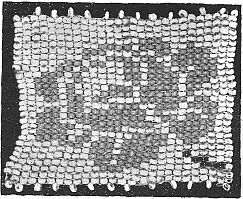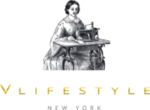Share This Article
Vintage and antique rose motifs are so in vogue right now. Rose patterns are seen everywhere: on bags, jeans, button down shirts. Below is a FREE rose motif pattern for bead work and could also be worked as fillet crochet or cross stitch pattern.
The below excerpt is from Needlework Economies, A book of Making and Mending with Oddments and Scraps, by Flora Klickmann published 1919.
Antique Rose Bead Pattern

“There are two modes of making the hand-made trimmings and bags, and, of course, this kind is worth much more than that made by machinery, as well as being more lasting and artistic.
In beaded crochet a coloured mercerised cotton, fine enough to pass easily through the beads selected, is used with a crochet-hook corresponding in fineness to the thread. The beads are first put on the thread, using a fine sewing needle for the purpose, or waxing the thread end; the beads are then worked into the design with the usual d c.
In the needle-made variety, which we are illustrating in this issue, each bead is attached to the bead immediately below it, and to the one following it. A very fine sewing needle, with fine linen or glazed cotton thread, is necessary.
Making The Rose Design

This beautiful design is suitable as a single motif for dress trimming, or as a repeat for tops of bags, etc.
Delft-blue china beads compose the background for the rose, which is of a deep pink colour, with small green stem.
Use fine linen thread and a very fine sewing needle. Thread 29 of the blue beads (or any other colour selected for the groundwork), run the needle back through the 28th bead (that is, insert the needle through the 28th bead, between the 28th and 29th, and bring it out through the 28th between that and the 27th), thread a bead, bring this bead over the 28th, and run the needle back through the 28th, as you did before, but run it through the 27th also; thread another bead, place it over the 27th, and run the needle back through the 27th and 26th beads; repeat with every 2 beads to the end. Turn.
3rd Row.—Thread a bead, run the needle back through the last bead in the 2nd row, thread a bead, run the needle back through the last bead again, in the same manner as before, and through the following bead; thread a bead, and continue as in the 2nd row, introducing the rose beads. After working 7 blue (b), there are 5 pink (p), 3 b, 3 p, 10 b.
4th Row.—9 b, 5 p, 1 b, 6 p, 7 b.
5th Row.—7 b, 6 p, 1 b, 5 p, 9 b.
6th Row.—8 b, 2 p, 8 b, 4 p, 6 b.
7th Row.—6 b, 1 p, 2 b, 1 p, 1 b, 6 p, 2 b, 2 p, 7 b.
8th Row.—7 b, 1 p, 1 b, 2 p, 2 b, 5 p, 2 b, 2 p, 6 b.
9th Row.—7 b, 2 p, 1 b, 2 p, 7 b, 1 p, 1 b, 2 p, 5 b.
10th Row.—5 b, 1 p, 1 b, 1 p, 5 b, 1 p, 1 b, 4 p, 2 b, 3 p, 4 b.
11th Row.—3 b, 5 p, 1 b, 4 p, 1 b, 2 p, 4 b, 1 p, 1 b, 2 p, 4 b.
12th Row.—4 b, 1 p, 1 b, 1 p, 4 b, 2 p, 1 b, 5 p, 1 b, 6 p, 2 b.
13th Row.—2 b, 1 p, 1 b, 1 p, 4 b, 5 p, 1 b, 2 p, 4 b, 1 p, 1 b, 1 p, 4 b.
14th Row.—4 b, 1 p, 1 b, 4 p, 1 b, 2 p, 1 b, 4 p, 2 b, 6 p, 2 b.
15th Row.—3 b, 6 p, 1 b, 4 p, 3 b, 4 p, 1 b, 1 p, 5 b.
16th Row.—3 b, 2 p, 1 b, 1 p, 4 b, 3 p, 1 b, 3 p, 1 b, 6 p, 3 b.
17th Row.—4 b, 5 p, 1 b, 1 p, 3 b, 8 p, 1 b, 2 p, 3 b.
18th Row.—3 b, 3 p, 1 b, 9 p, 2 b, 5 p, 5 b.
19th Row.—7 b, 2 p, 2 b, 1 p, 1 b, 7 p, 2 b, 2 p, 4 b.
20th Row.—6 b, 2 p, 1 b, 6 p, 1 b, 3 p, 9 b.
21st Row.—8 b, 3 p, 3 b, 1 p, 4 b, 4 p, 5 b.
22nd Row.—4 b, 4 p, 1 b, 4 p, 1 b, 1 p, 1 b, 5 p, 1 b, 1 green (g), 5 b.
23rd Row.—4 b, 1 g, 2 b, 5 p, 1 b, 2 p, 1 b, 7 p, 5 b.
24th Row.—5 b, 6 p, 2 b, 3 p, 1 b, 3 p, 3 b, 2 g, 3 b.
25th Row.—3 b, 1 g, 5 b, 5 p, 4 b, 3 p, 7 b.
26th Row.—24 b, 1 g, 3 b.
27th and 28th Rows.—All blue.
The bead at each turning is not included in the number given at the beginning of each row; this is the “turning” bead, and must be used in every row as in the 1st and 2nd rows.
